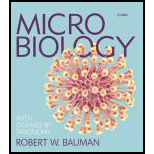
Parasitology is the study of
- a. viruses
- b. prokaryotes
- c.
fungi - d. eukaryotes
Introduction:
The prokaryotic cells and eukaryotic cells differ in many ways, out of which the most prominent difference is the difference in their genetic content. In addition, prokaryotic cells do not have membrane bound organelles and generally do not have cell wall, while eukaryotic cells exhibit these features.
Answer to Problem 1MC
Correct answer:
The study of parasitic eukaryotic organisms is termed as “parasitology”.
Therefore, option (d) is correct.
Option (d) is given as “eukaryotes”.
Explanation of Solution
Justify reasons for the correct statement:
The parasitic eukaryotic organisms include “helminthic parasites” and “protozoan parasites”. Some of the pathogenic protists of humans include Plasmodium vivax, Lamblia intestinalis, Entamoeba histolytica, and Trichomonas vaginalis. These protozoans invade the humans and harm the human hosts. The treatment of these protozoans is very difficult because of the similarities between protozoans with humans.
The parasites having multi cellularity are helminthic parasites that feed on nutrients from intestine of host organism. The study of parasitic eukaryotic organisms is “parasitology”.
Hence, option (d) is correct.
Justify reasons for the incorrect statements:
Option (a) is given as “viruses”.
The study of viruses is termed as “virology”. Hence, it is a wrong answer.
Option (b) is given as “prokaryotes”.
The prokaryotes either live free or are dependent on the host cells for nutrition. The parasitology is not the study of prokaryotes. Hence, it is a wrong answer.
Option (c) is given as “fungi”.
The “mycology” is termed as study of “fungi”. Hence, it is a wrong answer.
Hence, options (a), (b), and (c) are incorrect.
The study of “parasitic eukaryotic organisms” is termed as “parasitology”.
Want to see more full solutions like this?
Chapter 23 Solutions
Microbiology with Diseases by Taxonomy (5th Edition)
- Where did this structure originate from? (Salix branch root) epidermis cortex endodermis pericycle vascular cylinderarrow_forwardIdentify the indicated tissue. (Tilia stem x.s.) parenchyma collenchyma sclerenchyma xylem phloem none of thesearrow_forwardIdentify the indicated structure. (Cucurbita stem l.s.) pit lenticel stomate tendril none of thesearrow_forward
- Identify the specific cell? (Zebrina leaf peel) vessel element sieve element companion cell tracheid guard cell subsidiary cell none of thesearrow_forwardWhat type of cells flank the opening on either side? (leaf x.s.) vessel elements sieve elements companion cells tracheids guard cells none of thesearrow_forwardWhat specific cell is indicated. (Cucurbita stem I.s.) vessel element sieve element O companion cell tracheid guard cell none of thesearrow_forward
- Respond to the following in a minimum of 175 words: How might CRISPR-Cas 9 be used in research or, eventually, therapeutically in patients? What are some potential ethical issues associated with using this technology? Do the advantages of using this technology outweigh the disadvantages (or vice versa)? Explain your position.arrow_forwardYou are studying the effect of directional selection on body height in three populations (graphs a, b, and c below). (a) What is the selection differential? Show your calculation. (2 pts) (b) Which population has the highest narrow sense heritability for height? Explain your answer. (2 pts) (c) If you examined the offspring in the next generation in each population, which population would have the highest mean height? Why? (2 pts) (a) Midoffspring height (average height of offspring) Short Short Short Short (c) Short (b) Short Tall Short Tall Short Short Tall Midparent height (average height of Mean of population = 65 inches Mean of breading parents = 70 inches Mean of population = 65 inches Mean of breading parents = 70 inches Mean of population = 65 inches Mean of breading parents = 70 inchesarrow_forwardP You are studying a population of 100 flowers that has two alleles at a locus for flower color, blue (B) and green (G). There are 15 individuals with the BB genotype, 70 individuals with the BG genotype, and 15 individuals with the GG genotype. (a) What are the allele frequencies of B and G in the starting population? Show your calculations. (2 pts) (b) Is this population in Hardy-Weinberg equilibrium? Show your calculations. (3 pts) 12pt v Paragraph BIU UA AV & VT2V f CO Varrow_forward

 Comprehensive Medical Assisting: Administrative a...NursingISBN:9781305964792Author:Wilburta Q. Lindh, Carol D. Tamparo, Barbara M. Dahl, Julie Morris, Cindy CorreaPublisher:Cengage Learning
Comprehensive Medical Assisting: Administrative a...NursingISBN:9781305964792Author:Wilburta Q. Lindh, Carol D. Tamparo, Barbara M. Dahl, Julie Morris, Cindy CorreaPublisher:Cengage Learning Medical Terminology for Health Professions, Spira...Health & NutritionISBN:9781305634350Author:Ann Ehrlich, Carol L. Schroeder, Laura Ehrlich, Katrina A. SchroederPublisher:Cengage LearningBasic Clinical Lab Competencies for Respiratory C...NursingISBN:9781285244662Author:WhitePublisher:Cengage
Medical Terminology for Health Professions, Spira...Health & NutritionISBN:9781305634350Author:Ann Ehrlich, Carol L. Schroeder, Laura Ehrlich, Katrina A. SchroederPublisher:Cengage LearningBasic Clinical Lab Competencies for Respiratory C...NursingISBN:9781285244662Author:WhitePublisher:Cengage





